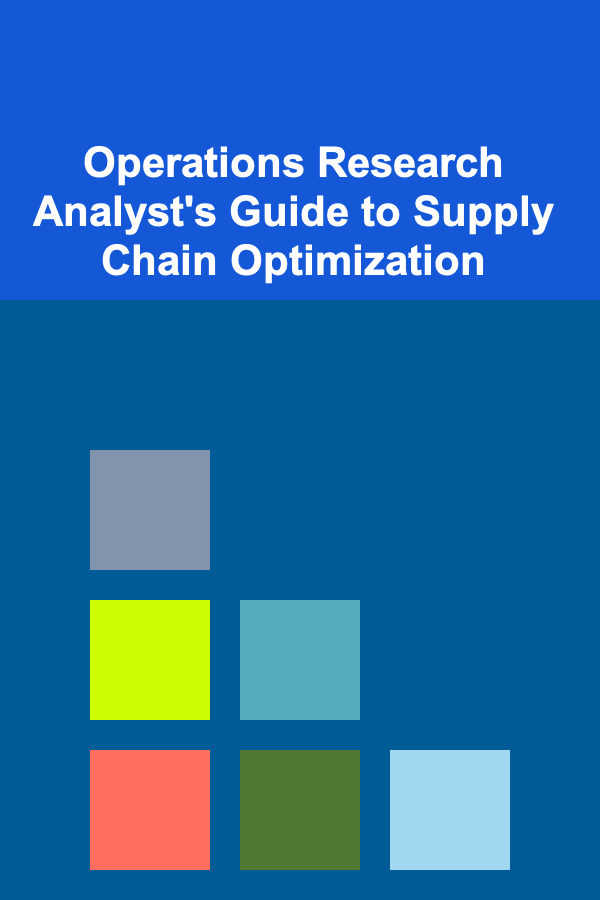
Operations Research Analyst's Guide to Supply Chain Optimization
ebook include PDF & Audio bundle (Micro Guide)
$12.99$10.99
Limited Time Offer! Order within the next:

Supply chain optimization is a vital area of focus for businesses aiming to increase efficiency, reduce costs, and enhance customer satisfaction. Operations research (OR) analysts play a crucial role in this process by using mathematical models, statistical analysis, and advanced algorithms to help organizations make better decisions. This actionable guide delves deep into the techniques, tools, and methodologies used by operations research analysts to optimize supply chains, providing a comprehensive approach to solving complex logistics and production problems.
Understanding Supply Chain Optimization
Supply chain optimization involves improving the flow of goods, information, and finances across the entire supply chain---from raw material procurement to product delivery to end customers. The objective is to maximize efficiency, reduce operational costs, and ensure timely delivery while maintaining or improving quality standards.
Key Components of Supply Chain Optimization
- Inventory Management: Ensuring that the right amount of inventory is available at the right time and at the right location.
- Transportation Optimization: Efficient management of transportation resources, including vehicle routing, scheduling, and load optimization.
- Demand Forecasting: Accurate prediction of future customer demand to align production and inventory levels with market needs.
- Supplier Relationship Management: Optimizing supplier selection and coordination to reduce costs and improve quality.
For an operations research analyst, understanding these components and how they interconnect is essential for devising optimization strategies that lead to significant improvements.
Operations Research Methodologies for Supply Chain Optimization
Operations research offers several methodologies that can be applied to optimize various aspects of the supply chain. Below are some of the most widely used techniques:
2.1. Linear Programming (LP)
Linear programming is one of the most fundamental techniques used in supply chain optimization. It involves creating a mathematical model that maximizes or minimizes an objective function (e.g., cost, time, or profit) subject to constraints (e.g., supply limits, demand requirements, and transportation capacities).
- Applications :
- Production Planning: Optimizing the allocation of resources in production while minimizing costs.
- Distribution Optimization: Determining the most cost-effective way to distribute goods from warehouses to customers.
Actionable Tip: For an efficient linear programming model, ensure that your objective function accurately reflects your company's goals (e.g., minimizing transportation costs) and that all relevant constraints are included (e.g., delivery time windows, warehouse capacity).
2.2. Integer Programming (IP)
Unlike linear programming, integer programming deals with decision variables that must be whole numbers. This is particularly useful in supply chain optimization when decisions are binary (e.g., whether to open a new warehouse) or involve discrete quantities (e.g., number of trucks).
- Applications :
- Facility Location: Determining the optimal location for warehouses, factories, or distribution centers.
- Fleet Management: Deciding the number of vehicles required for transportation and their routing.
Actionable Tip: Use integer programming when dealing with discrete choices such as facility openings, fleet sizing, or the allocation of products to different facilities. This will allow you to obtain actionable, real-world solutions.
2.3. Network Optimization
Network optimization focuses on optimizing the entire network of suppliers, manufacturers, warehouses, and retailers. This methodology is particularly helpful in improving the flow of goods and information across the supply chain.
- Applications :
- Transportation Network Design: Optimizing the routing of vehicles and the design of distribution routes.
- Supply Chain Network Flow: Minimizing the costs associated with transporting goods through the supply chain network.
Actionable Tip: Leverage network flow algorithms to evaluate the entire supply chain network's performance and identify bottlenecks or inefficiencies in transportation and storage that could increase overall costs.
2.4. Queuing Theory
Queuing theory is used to model systems where customers or goods must wait in line before receiving a service, such as in manufacturing or at distribution points. By applying queuing theory, OR analysts can reduce waiting times, enhance throughput, and optimize the allocation of resources.
- Applications :
- Inventory Replenishment: Optimizing reorder points and inventory levels to minimize stockouts and overstocking.
- Warehouse Optimization: Reducing delays in processing orders and improving flow inside warehouses.
Actionable Tip: Apply queuing models to reduce bottlenecks in order fulfillment processes, ensuring that goods are processed and shipped to customers as efficiently as possible.
2.5. Simulation Modeling
Simulation allows OR analysts to model real-world supply chain processes and test different scenarios to determine the best course of action under various conditions. This method is particularly useful for handling complex systems with uncertainty and variability.
- Applications :
- Demand Uncertainty: Simulating different demand patterns to evaluate supply chain responsiveness.
- Production Scheduling: Testing various scheduling methods to optimize production efficiency.
Actionable Tip: Use Monte Carlo simulations to account for uncertainty in demand and supply, and run multiple scenarios to identify the most effective supply chain strategies under various conditions.
Key Techniques in Supply Chain Optimization
Beyond the foundational OR methodologies, there are several advanced techniques that OR analysts use to refine supply chain processes and make real-time decisions.
3.1. Demand Forecasting and Inventory Management
Accurate demand forecasting is critical for optimizing inventory levels and reducing costs associated with stockouts and overstocking. OR analysts use statistical methods and machine learning algorithms to predict future demand based on historical data, market trends, and seasonal patterns.
- Techniques :
- Time Series Analysis: Using historical data to predict future demand patterns.
- Exponential Smoothing: A forecasting method that gives more weight to recent demand data.
Actionable Tip: Incorporate machine learning models for demand forecasting to improve accuracy over traditional time series methods, especially in dynamic markets with fluctuating demand.
3.2. Supply Chain Risk Management
Supply chain optimization is not only about maximizing efficiency but also about managing risks such as supply disruptions, transportation delays, or sudden spikes in demand. Risk management models help identify vulnerabilities and provide strategies for mitigating risks.
- Techniques :
- Scenario Planning: Simulating different risk scenarios (e.g., natural disasters, supply shortages) and their impact on the supply chain.
- Resilient Supply Chain Design: Developing a supply chain that can quickly adapt to changes and disruptions.
Actionable Tip: Use simulation modeling and real-time data analytics to predict potential disruptions and create contingency plans to minimize their impact on your supply chain operations.
3.3. Transportation and Distribution Optimization
Transportation is one of the most significant costs in supply chain management. Operations research analysts optimize transportation by considering factors such as routing, scheduling, and load optimization.
- Techniques :
- Vehicle Routing Problem (VRP): Optimizing the routes of delivery vehicles to minimize travel time and reduce fuel consumption.
- Multi-modal Transportation: Integrating different modes of transportation (e.g., truck, rail, sea) to optimize cost and efficiency.
Actionable Tip: Apply the VRP to minimize transportation costs by optimizing vehicle routes and schedules. Use GPS tracking and real-time data to adjust routes dynamically and reduce delays.
3.4. Supplier Selection and Procurement Optimization
Efficient supplier management is essential to maintaining cost-effectiveness and product quality in the supply chain. OR analysts use optimization techniques to determine the best suppliers, manage supplier relationships, and ensure timely procurement of raw materials.
- Techniques :
- Supplier Evaluation Models: Evaluating suppliers based on cost, quality, reliability, and capacity.
- Multi-Criteria Decision Analysis (MCDA): A method for evaluating and comparing suppliers based on multiple criteria.
Actionable Tip: Use MCDA to weigh various supplier factors and optimize supplier selection. Regularly assess supplier performance and adjust procurement strategies to mitigate risks related to quality or delivery.
Real-Time Data Analytics for Dynamic Supply Chain Optimization
In the modern era, supply chains must adapt quickly to changing market conditions. Real-time data analytics empowers OR analysts to make data-driven decisions on the fly and optimize supply chain operations in real-time.
- Tools :
- IoT and RFID: Real-time tracking of goods in transit and inventory.
- Big Data Analytics: Analyzing large volumes of data to identify trends, inefficiencies, and opportunities for optimization.
Actionable Tip: Implement IoT-enabled tracking systems to monitor the movement of goods in real-time, and use predictive analytics to anticipate disruptions and optimize supply chain processes.
Collaboration and Continuous Improvement in Supply Chain Optimization
Effective supply chain optimization requires collaboration across departments and continuous improvement. OR analysts must work closely with logistics, procurement, and production teams to align supply chain strategies with business objectives.
- Techniques :
- Collaborative Forecasting: Sharing demand and supply information across the supply chain to improve forecast accuracy.
- Kaizen (Continuous Improvement): Using feedback loops to continuously refine supply chain processes and drive incremental improvements.
Actionable Tip: Foster a culture of collaboration between all supply chain stakeholders to share information and make real-time decisions. Use continuous feedback to improve processes and optimize performance over time.
Conclusion
Supply chain optimization is an ongoing, dynamic process that requires a combination of advanced methodologies, real-time data, and collaborative efforts across teams. Operations research analysts are at the forefront of this process, using a variety of mathematical models and optimization techniques to drive efficiency, reduce costs, and improve decision-making. By embracing tools such as linear programming, network optimization, and real-time analytics, businesses can gain a competitive edge and deliver value to customers in an increasingly complex global supply chain.

How to Create a Warm and Inviting Holiday Atmosphere with Candles
Read More
How to Review and Adjust Your Financial Plan Annually
Read More
How to Simplify Your Daily Routine for Less Clutter
Read More
How to Throw a Glamorous Cocktail Party in a Small Space
Read More
How To Interpret Blockchain Security Best Practices
Read More
Flying Stars Feng Shui: Understanding Timely Energies
Read MoreOther Products

How to Create a Warm and Inviting Holiday Atmosphere with Candles
Read More
How to Review and Adjust Your Financial Plan Annually
Read More
How to Simplify Your Daily Routine for Less Clutter
Read More
How to Throw a Glamorous Cocktail Party in a Small Space
Read More
How To Interpret Blockchain Security Best Practices
Read More